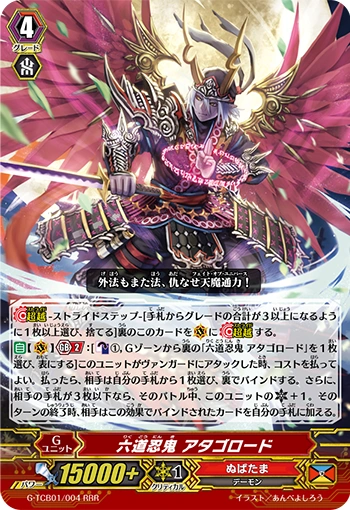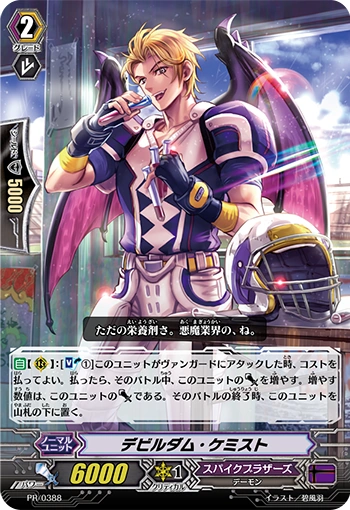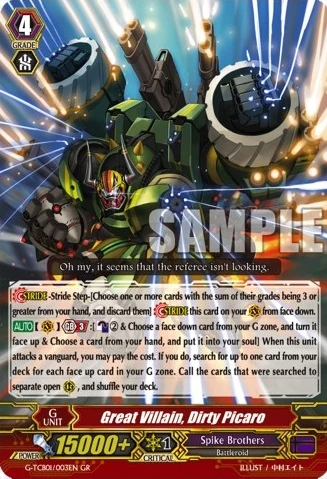New Card #1:
Rikudo Stealth Rogue, Atagolord.
 |
| Dishonourable? Honour is but a path to an early demise! |
(Stride)
(Auto) (VC) (GB2) [:(CB1) & Choose a face down card named "Rikudo Stealth Rogue, Atagolord" from your G-Zone, and turn it face up]: When this unit attack's a vanguard, you may pay the cost. If you do, your opponent chooses a card from his or her hand, and binds it face up. Then if the amount of cards in your opponent's hand is three or less, this unit gets (critical) +1 until end of turn. The cards bound with this effect return to the opponent's hand at the end of the turn.
Nubatama's G-Persona from The RECKLESS RAMPAGE, This card's skill appears to be weak... But like a true ninja, this is deliberate deception.
This card is actually pretty powerful, and I'll tell you why.
Atagolord requires the opponent to have four or less cards in hand when he attacks to get his critical skill.
So, how hard is it to get your opponent to 4 cards in hand by the time Atagolord attacks? First lets start of by assuming a very likely scenario: Atagolord has strode over Shiranui. Assuming you can use both skills, that increases the maximum hand size to five cards. Next, let's assume that we're break-riding over Kujikiricongo, then striding into Atagolord. That further increases the maximum hand size to six. Lastly, let's assume thatyou break-ride Shiranui over Kujikiricongo, then stride into Atagolord, and are able to use both skills, that increases even futher to seven cards.
Note that none of these examples require any rearguards to work.
Atagolord requires the opponent to have four or less cards in hand when he attacks to get his critical skill.
So, how hard is it to get your opponent to 4 cards in hand by the time Atagolord attacks? First lets start of by assuming a very likely scenario: Atagolord has strode over Shiranui. Assuming you can use both skills, that increases the maximum hand size to five cards. Next, let's assume that we're break-riding over Kujikiricongo, then striding into Atagolord. That further increases the maximum hand size to six. Lastly, let's assume thatyou break-ride Shiranui over Kujikiricongo, then stride into Atagolord, and are able to use both skills, that increases even futher to seven cards.
Note that none of these examples require any rearguards to work.
Admittedly, the latter situation is not the consistent combo in the world, so we can assume that seven cards is the upper limits of Atagolord's viability, as it is very hard to get higher then this number consistently.
This is around the size of the average hand at this stage in the game.
Any higher then this and Tsukumorikan becomes more viable.
So what does this prove? It proves that Atagolord is the main finisher for Nubatama, that Atagolord is relatively consistent and that it's "heavy condition" is not really a heavy condition at all.
Verdict: Very Powerful. Do not underestimate this card.
This is around the size of the average hand at this stage in the game.
Any higher then this and Tsukumorikan becomes more viable.
So what does this prove? It proves that Atagolord is the main finisher for Nubatama, that Atagolord is relatively consistent and that it's "heavy condition" is not really a heavy condition at all.
Verdict: Very Powerful. Do not underestimate this card.
Old card #1
Stealth Beast, Tamahagane.
 |
| World's worst care bear. |
(Auto) ]: When this unit is placed on (VC) or (RC), Choose up to one of your opponent's rearguards, and your opponent binds that card face up and at the end of that turn, your opponent puts the card bound by this effect into his or her hand.
Tamahagane is an card that was once useful mainly for binding rearguard during the early and mid game so that Kuroko can snipe, he is now a all-round useful card, mainly thanks to Nubatama's new keyword, afterimage.
This card now has one or two uses, depending on whether you run Kuroko or Kamojiqusha as your starter. It can either be used to snipe rearguards early game using Kuroko, or it can be used to activate afterimage. Both of these are viable and reasonable ways of using this effect in my opinion.
In the late game, Tamahagane is a great backup bind in case you are in a situation where you simply cannot bind, or you need to bind a new card, but otherwise he can be a bit of a deadweight.
Nonetheless, he is a vital card to Nubatama's strategy, no matter what style you play.
Verdict: Pretty good.
New card #2:
Devildam Chemist
 |
| It was me, Dio! |
(Auto) (RC) :[(SB)1]: When this unit attacks a vanguard, you may pay the cost. If you do, increase this units (power) by this unit's current (power) until the end of the battle. At the end of that battle, put this unit to the bottom of your deck.
Highspeed, Brakki is a card that has always been a staple of Spike Brothers since it's inception.
This card is an interesting version of that card. Whilst it's base power is abysmal, it increases it's power by whatever power it was when it attacked. That includes triggers, effects and boosted power.
This allows it's power to increase exponentially with it's skill. For example, say you broke-rode Bloody Ogle over Bad End Dragger, and then Legioned. When this unit attacked, if you used it's skill, it would actually attack for 42k unboosted, and 56k if boosted by a 7K,
These are some really scary numbers, especially for a deck that can call out the same card several times a turn.
It's just a card that you'll never want to ride. Ever.
Verdict: I really don't want to be on the receiving end of this...
Old card #2:
Great Villain, Dirty Picaro.
 |
| About as dirty as most pro Football (Soccer if you're American) players. |
(Stride)
(Auto) (VC) (GB3) :[(CB)1 & choose a face down card in your G-Zone, and turn it face up and choose a card from your hand, and put it into your soul]: When this unit attacks a vanguard, you may pay the cost. If you do, search your deck for up to one card from your deck for every face up card in your G-Zone. Call the cards that were searched to separate open (RC), and shuffle your deck.
Spike Brother's G-Rare from the RECKLESS RAMPAGE, Dirty Picaro is pretty much Dudley Emperor retrained as a G-Unit.
Spikes are known for their heavy consumption of resources, mainly counterblasts and rearguards. A card that can quickly trade one of them for others is pretty good, especially since you are not restricted in what you search.
Spikes have plenty of good targets to call. Axe Diver and Misery are some of the new ones, with Devildam, Reckless and Mason being some other useful cards.
It's GB3 condition might seem harsh at first, but Miracle Ace and Dudley Geronimo can both persona on the first turn, allowing you to use Picaro from the second stride onwards.
Verdict: Very useful. Gives the clan a quick way to replenish resources.
Spike Brother's G-Rare from the RECKLESS RAMPAGE, Dirty Picaro is pretty much Dudley Emperor retrained as a G-Unit.
Spikes are known for their heavy consumption of resources, mainly counterblasts and rearguards. A card that can quickly trade one of them for others is pretty good, especially since you are not restricted in what you search.
Spikes have plenty of good targets to call. Axe Diver and Misery are some of the new ones, with Devildam, Reckless and Mason being some other useful cards.
It's GB3 condition might seem harsh at first, but Miracle Ace and Dudley Geronimo can both persona on the first turn, allowing you to use Picaro from the second stride onwards.
Verdict: Very useful. Gives the clan a quick way to replenish resources.
No comments:
Post a Comment